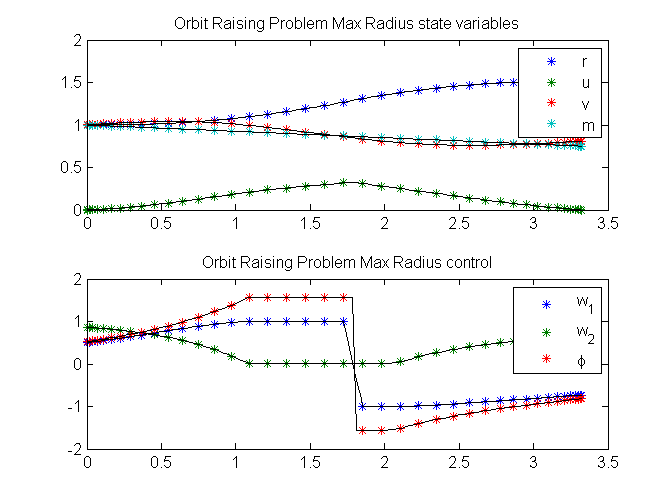PROPT Orbit Raising Maximum Radius: Difference between revisions
From TomWiki
Jump to navigationJump to search
No edit summary |
|||
| (2 intermediate revisions by one other user not shown) | |||
| Line 6: | Line 6: | ||
<math> J = r(t_f) </math> | <math> J = r(t_f) </math> | ||
subject to the dynamic constraints | subject to the dynamic constraints | ||
<math> \frac{d_r}{dt} = u </math> | <math> \frac{d_r}{dt} = u </math> | ||
<math> \frac{du}{dt} = \frac{v^2}{r}-\frac{mmu}{r^2}+T*\frac{w1}{m} </math> | <math> \frac{du}{dt} = \frac{v^2}{r}-\frac{mmu}{r^2}+T*\frac{w1}{m} </math> | ||
<math> \frac{dv}{dt} = -u*\frac{v}{r}+T*\frac{w2}{m} </math> | <math> \frac{dv}{dt} = -u*\frac{v}{r}+T*\frac{w2}{m} </math> | ||
<math> \frac{dm}{dt} = -\frac{T}{g0*ISP} </math> | <math> \frac{dm}{dt} = -\frac{T}{g0*ISP} </math> | ||
the boundary conditions | the boundary conditions | ||
<math> r(t_0) = 1 </math> | <math> r(t_0) = 1 </math> | ||
<math> u(t_0) = 1 </math> | <math> u(t_0) = 1 </math> | ||
<math> u(t_f) = 0 </math> | <math> u(t_f) = 0 </math> | ||
<math> v(t_0) = (\frac{mmu}{r(t_0)})^{0.5} </math> | <math> v(t_0) = (\frac{mmu}{r(t_0)})^{0.5} </math> | ||
<math> v(t_f) = (\frac{mmu}{r(t_f)})^{0.5} </math> | <math> v(t_f) = (\frac{mmu}{r(t_f)})^{0.5} </math> | ||
<math> m(t_0) = 1 </math> | <math> m(t_0) = 1 </math> | ||
and the path constraint | and the path constraint | ||
<math> w_1^2+w_2^2 = 1 </math> | <math> w_1^2+w_2^2 = 1 </math> | ||
The control pitch angel is not being used in this formulation. Instead two control variables (w1,w2) are used to for the thrust direction. A path constraint ensures that (w1,w2) is a unit vector. | The control pitch angel is not being used in this formulation. Instead two control variables (w1,w2) are used to for the thrust direction. A path constraint ensures that (w1,w2) is a unit vector. | ||
| Line 104: | Line 116: | ||
<pre> | <pre> | ||
Problem type appears to be: lpcon | Problem type appears to be: lpcon | ||
Time for symbolic processing: 0. | Time for symbolic processing: 0.22212 seconds | ||
Starting numeric solver | Starting numeric solver | ||
===== * * * =================================================================== * * * | ===== * * * =================================================================== * * * | ||
| Line 119: | Line 131: | ||
FuncEv 1 ConstrEv 59 ConJacEv 59 Iter 36 MinorIter 346 | FuncEv 1 ConstrEv 59 ConJacEv 59 Iter 36 MinorIter 346 | ||
CPU time: 0. | CPU time: 0.202801 sec. Elapsed time: 0.226000 sec. | ||
</pre> | </pre> | ||
| Line 138: | Line 150: | ||
[[File:orbitRaisingMaxRadius_01.png]] | [[File:orbitRaisingMaxRadius_01.png]] | ||
[[Category:PROPT Examples]] | |||
Latest revision as of 05:33, 14 February 2012
|
This page is part of the PROPT Manual. See PROPT Manual. |
Problem description
Maximize:
subject to the dynamic constraints
the boundary conditions
and the path constraint
The control pitch angel is not being used in this formulation. Instead two control variables (w1,w2) are used to for the thrust direction. A path constraint ensures that (w1,w2) is a unit vector.
% Copyright (c) 2007-2009 by Tomlab Optimization Inc.Problem setup
t_F = 3.32;
mmu = 1;
m_0 = 1; r_0 = 1; u_0 = 0;
u_f = 0; v_0 = sqrt(mmu/r_0); rmin = 0.9;
rmax = 5; umin = -5; umax = 5;
vmin = -5; vmax = 5; mmax = m_0;
mmin = 0.1;
T = 0.1405;
Ve = 1.8758;
toms t
p1 = tomPhase('p1', t, 0, t_F, 40);
setPhase(p1);
tomStates r u v m
tomControls w1 w2
% Initial guess
x0 = {icollocate({
r == r_0
u == u_0 + (u_f-u_0)*t/t_F
v == v_0
m == m_0})
collocate({w1 == 0; w2 == 1})};
% Boundary constraints
cbnd = {initial({
r == r_0
u == u_0
v == v_0
m == m_0
})
final({u == u_f
v - sqrt(mmu/r) == 0})};
% Box constraints
cbox = {
rmin <= icollocate(r) <= rmax
umin <= icollocate(u) <= umax
vmin <= icollocate(v) <= vmax
mmin <= icollocate(m) <= mmax
-1 <= collocate(w1) <= 1
-1 <= collocate(w2) <= 1};
% ODEs and path constraints
ceq = collocate({
dot(r) == u
dot(u) == v^2/r-mmu/r^2+T*w1/m
dot(v) == -u*v/r+T*w2/m
dot(m) == -T/Ve
w1^2+w2^2 == 1});
% Objective
objective = -final(r);Solve the problem
options = struct;
options.name = 'Orbit Raising Problem Max Radius';
options.solver = 'snopt';
solution = ezsolve(objective, {cbox, cbnd, ceq}, x0, options);Problem type appears to be: lpcon
Time for symbolic processing: 0.22212 seconds
Starting numeric solver
===== * * * =================================================================== * * *
TOMLAB - TOMLAB Development license 999007. Valid to 2011-12-31
=====================================================================================
Problem: --- 1: Orbit Raising Problem Max Radius f_k -1.518744202740535800
sum(|constr|) 0.000017265830060524
f(x_k) + sum(|constr|) -1.518726936910475200
f(x_0) -0.999999999999991120
Solver: snopt. EXIT=0. INFORM=1.
SNOPT 7.2-5 NLP code
Optimality conditions satisfied
FuncEv 1 ConstrEv 59 ConJacEv 59 Iter 36 MinorIter 346
CPU time: 0.202801 sec. Elapsed time: 0.226000 sec.
Plot result
subplot(2,1,1)
ezplot([r u v m]);
legend('r','u','v','m');
title('Orbit Raising Problem Max Radius state variables');
subplot(2,1,2)
ezplot([w1 w2 atan2(w1,w2)])
legend('w_1', 'w_2', '\phi');
title('Orbit Raising Problem Max Radius control');











